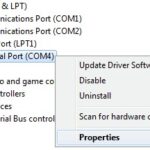Navigating the electrical system of a 2004 Ford F250 diesel can be daunting, especially when troubleshooting issues related to the fuel system or engine control. Understanding the OBD2 wiring diagram is crucial for any DIY mechanic or technician working on these robust trucks. This guide delves into the essentials of the 2004 Ford F250 Diesel Obd2 Wiring Diagram, providing insights to help you diagnose and address common electrical problems.
Decoding the Fuel Pump Relay and PCM Timer
One common area of concern is the fuel pump relay, often controlled by the Powertrain Control Module (PCM) timer. The PCM manages the fuel pump operation, and understanding its wiring is key to diagnosing fuel delivery problems. The PCM can shut down the fuel pump by disconnecting the ground to the fuel pump relay. To check if the PCM is attempting to shut off the fuel pump, you can monitor the ground wire. For a 2006 model (similar principles apply to the 2004), this involves checking the ground wire at the CJB (Central Junction Box) connector or the PCM connector itself. You should find continuity to ground when the key is in the “ON” position. After turning the key off, this continuity should disappear within a few minutes. If this ground signal is not behaving as expected, it could indicate a PCM issue. However, if the PCM ground signal is correct, wiring problems elsewhere in the system become a more likely culprit.
Power Relays: PCM and FICM
The ignition switch plays a crucial role in powering up the truck’s electronic systems. Turning the ignition to “ON” should activate the PCM Power Relay. Once this relay is engaged, the PCM receives power through a designated fuse in the CJB. This action also typically activates the fuel pump, which is designed to time out if the engine does not start within a short period, usually around 20 seconds.
In addition to the PCM, the Fuel Injection Control Module (FICM) is another critical component with its own power relay. Fuses, often hot at all times, supply power to the FICM Power Relay. The FICM itself initially receives power directly from the ignition switch. Once powered, it grounds the FICM Power Relay, which then delivers higher amperage power from another fuse to the FICM. Understanding this power distribution is essential when diagnosing FICM related issues, which can significantly impact engine performance.
Addressing Complex Electrical Issues and Modifications
Troubleshooting electrical problems in a 2004 Ford F250 diesel can become significantly more complex when modifications or previous repairs are involved. If the vehicle has had aftermarket alarm systems installed and subsequently removed, or if components like the CJB have been replaced with non-original parts, diagnosis becomes increasingly challenging. These modifications can introduce wiring discrepancies and unexpected issues that are difficult to resolve without a thorough understanding of the original wiring diagrams and careful inspection.
In situations involving significant unknowns and potential wiring alterations, remote troubleshooting advice can be limited in its effectiveness. Resolving these complex electrical problems often necessitates hands-on diagnostics, access to the correct 2004 Ford F250 diesel OBD2 wiring diagram, and potentially the expertise of a professional technician familiar with these systems. Ensuring all replacement parts, especially critical modules like the CJB or PCM, are correct for the specific vehicle is also paramount for accurate diagnosis and repair.
Conclusion
For owners and technicians working on a 2004 Ford F250 diesel, a detailed OBD2 wiring diagram is an indispensable tool for diagnosing and repairing electrical issues. Understanding the function of the PCM, fuel pump relay, FICM, and associated power circuits is crucial for effective troubleshooting. When faced with complex problems, especially in vehicles with a history of modifications or component replacements, consulting the wiring diagram and seeking professional expertise may be necessary to ensure accurate and safe repairs.

